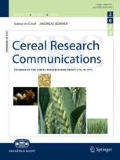Abstract
The inherent precision of spot blotch (SB) and common root rot (CRR) screening procedure through repeatability analysis was evaluated in seedling plants of three barley genotypes (Thibaut, WI2291 and AECS 76). High repeatability of assessments obtained by partitioning of variance components (69.0 to 86.0) for BS and (75.0 to 85.0) for CRR. On the basis of the variance component estimate, gain in precision was calculated using Falconer method. The results show that a moderate increase of precision (~ 2% for SB and ~ 4% for CRR) may be acquired through repeating the screening a second time for both diseases. Attained information from this study suggests that seedling screening of both SB and CRR under controlled conditions provides consistent information on host response, and reliable host reaction information could be obtained through a less number of repeated evaluations.
Similar content being viewed by others
References
Anonymous, 1988. STAT-ITCF, Programme, MICROSTA, realized by ECOSOFT, 2nd Ver. Institut Technique des Cereals et des Fourrages Paris, pp.55.
Arabi, M. I. E.,and Jawhar, M. 1999. A rapid technique for determining common root rot reaction in barley. Plant Breeding 118:278–280.
Arabi, M. I. E. and Jawhar, M. 2002. Virulence spectrum to barley Hordeum vulgare L.) in some isolates of Cochliobolus sativus from Syria. J. Plant Pathol. 84: 35–39.
Arabi, M. E. I. and Jawhar, M. 2003. Pathotypes of Cochliobolus sativus (spot blotch) on barley in Syria. J. Plant Pathol. 85(3), 193–196.
Arabi, M. I. E., Sarrafi, A., Barrault, G. and Albertin, L. 1991. The influence of parental genotype and period of pollination on haploid barley production in Hordeum vulgare × H. bulbosum L. crosses. Cereal Res. Comm. 4:405–412.
Bailey, K. L., Knott, D. R. and Harding, H. 1988. Heritability and inheritance of resistance to common root rot (Cochliobolus sativus) in wheat (Triticum aestivum L.) Can. J. Plant Pathol. 10: 207–214.
Becker, W. A. 1984. Manual of quantitative genetics. 4th Ed. Academic Enterprises, Pullman, W.A.
Conner, R. L. 1990. Interrelationship of cultivar reactions to common root rot, black point, and spot blotch in spring wheat. Plant Dis. 74:224–227.
Falconer, D. S. 1981. Introduction to quantitative genetics. 2nd Ed. Longman Inc., New York, NY.
Fetch, T. C. and Steffenson, B. J. 1994. Identification of Cochliobolus sativus isolates expressing differential virulence on two-row barley genotypes from North Dakota. Can. J. Plant Pathol. 16:202–206.
Fetch, T. C. and Steffenson B. J. 1999. Rating scales for assessing infection responses of barley infected with Cochliobolus sativus. Plant Dis. 83: 231–1217.
Hetzler, J., Eyal Z., Metha, Y. R., Campos, L. A., Fehrmann, H., Kushnir, U., Zekaria, J. O. and Cohen, L., 1990. Interaction between spot blotch Cochliobolus sativus) and wheat cultivars. A proceeding of the International conference. Mexico, DF (Mexico). CIMMYT. 146–164.
Kokko, E. G., Conner, R. L., Kozub, G. C. and Lee, B. 1993. Quantification by image analysis of subcrown internodes discoloration in wheat caused by common root rot. Phytopathology 83: 976–981.
Kutcher, H. R., Bailey, K. L. Rossmagel, B. G. and Legge, W. C. 1994. Heritability of common root rot and spot blotch resistance in barley. Can. J. Plant Pathol. 16: 287–294.
Mathre, D. E. 1990. Compendium of Barley Disease (second edition). Montana State University. Bozeman, Montana. The American Phytopathologie Society, St. Paul, Minnesota, USA pp. 90.
Meldrum, S. M., Ogle, H. J. and Platz, G. J. 2000. Pathotypes of Bipolaris sorokiniana on barley in Australia. Proceedings of the 9th Australian Barley Technical Symposium, Melbourne, Australia.
Nutter, F. W. Jr., Gleason, M. L. Jenco, J. H. and Christians, N. C. 1993. Assessing the accuracy, intra-rater repeatability, and inter-rater reliability of disease assessment systems. Phytopathology 83: 806–812.
Steffenson, B. J., Hayes, P. M. and Kleinhofs, A., 1996. Genetics of seedling and adult plant resistance to net blotch (Pyernophora teres f. teres) and spot blotch (Cochliobolus stivus) in barley. Theor. Appl. Genet. 92: 552–558.
Van Leur, J. G., Alamdar, M. Z. and Khawatmi, S. 1997. Effect of Cochliobolus sativus on yields of barley under experimental conditions in northern Syria. Aust. J. Agric. Res. 48: 1–7.
Zadoks, J. G, Chang, T. T. and Konzak, C. F. 1974. A decimal code for the growth stages of cereals. Weed Research 14:415–421.
Zhang, X., Haley, S. D. and Jin, Y. 2002. Repeatability of assays for seedling septoria tritici blotch resistance in winter wheat. Cereal Res. Comm. 30:157–163.
Author information
Authors and Affiliations
Corresponding author
Rights and permissions
About this article
Cite this article
Arabi, M.I.E., Jawhar, M. Repeatability of Barley Seedling Reaction to Spot Blotch and Common Root Rot. CEREAL RESEARCH COMMUNICATIONS 32, 249–253 (2004). https://doi.org/10.1007/BF03543306
Received:
Accepted:
Published:
Issue Date:
DOI: https://doi.org/10.1007/BF03543306




